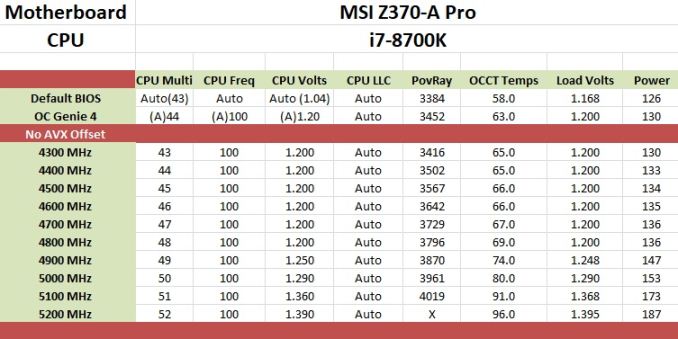The MSI Z370-A Pro Motherboard Review: Entry Level Business (And Pleasure)
by Joe Shields on September 11, 2018 8:00 AM EST- Posted in
- Motherboards
- MSI
- Coffee Lake
- Z370
- i7-8700K
- Z370A-Pro
- Pro Series
Overclocking
Experience with the MSI Z370-A Pro
Overclocking using the MSI Z370-A Pro went better than expected. Being a board designed for business (and is good for mining according to the webpage), overclocking prowess isn't generally in the cards, particularly at towards the limits. That said, the board and its power delivery system were unphased at the end of testing handling the 5.1 GHz overclock.
MSI motherboards in the non-Pro series use their Gameboost functionality to 'one-touch' overclock. We have seen in the past, across all AIBs, that these one button overclocks tend to do very little and/or raise voltages to levels not needed. In this case, the Z370-A Pro raised clocks by 100 MHz all around. This yielded 4.4 GHz all cores and 4.8 GHz single core. The board set the voltage at 1.2V which was an acceptable value for the clocks (specifically the 4.8 GHz single core). Performance improvements from 100 MHz aren't typically tangible to most users, but the more the better regardless.
With manual overclocking, the Z370-A Pro was able to match other more expensive boards in overclocking reaching 5.1 GHz. There was little to no vdroop while using auto so it was left at that setting. At 5.1 GHz I had to use a little more voltage (0.025V) than what the other boards average for stability in our testing, but, this could also be due to the not always precise software readings (the board does not have voltage read points).
Overall overclocking on the Z370-A Pro was as easy as any other unlocked Intel processor. The BIOS had all the required options to successfully and safely push the i7-8700K past the 5 GHz threshold. The Command Center software proved functional for our uses in overclocking allowing a quicker turnaround than rebooting to the BIOS to change different settings.
Overclocking Methodology
Our standard overclocking methodology is as follows. We select the automatic overclock options and test for stability with POV-Ray and OCCT to simulate high-end workloads. These stability tests aim to catch any immediate causes for memory or CPU errors.
For manual overclocks, based on the information gathered from the previous testing, starts off at a nominal voltage and CPU multiplier, and the multiplier is increased until the stability tests are failed. The CPU voltage is increased gradually until the stability tests are passed, and the process repeated until the motherboard reduces the multiplier automatically (due to safety protocol) or the CPU temperature reaches a stupidly high level (90ºC+). Our test bed is not in a case, which should push overclocks higher with fresher (cooler) air.
Overclocking Results
The MSI Z370-A Pro was able to take our i7-8700K to 5.1 GHz at 1.368V. This is a bit more than what was needed out of the other boards but nothing out of the ordinary or alarming. The board handled the faster 3200 MHz memory without issue using the XMP profile and also was able to overclock to 3600 MHz. Overall, the overclocking abilities are there and the board will not be a limiting factor in ambient overclocks.












12 Comments
View All Comments
AtomicMuffin - Sunday, February 17, 2019 - link
I too liked the color scheme they used. Also if rgb is off puting you can use mystic light app in silent mode. Where it boots with windows and is automatically hidden disabling the rgb strip that board has on it's backside.Samus - Tuesday, September 11, 2018 - link
My Z97-A Pro was free from Microcenter during the Pentium G promo...and that's about all it was worth. Nothing but problems with that board and eventually pulled it, smashed it, and threw it in the garbage out of frustration. Put in an Asus Z97 to replace it, works fine to this day.